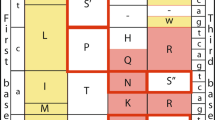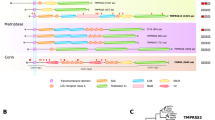Abstract
The organization and sequence of genes encoding the α1-proteinase inhibitor (α1PI), a major serine proteinase inhibitor of the mammalian bloodstream, have been compared in several species, including murine rodents (genus Mus). Analysis of gene copy number indicates that amplification of α1PI genes occurred at some time during evolution of the Mus genus, leading to fixation of a family of about three to five genes in several existing species (e.g., M. domesticus and M. saxicola), and only a single gene in others (e.g., M. caroli). A phylogeny for the various mammalian α1PI mRNAs was constructed based upon synonymous substitutions within coding regions. The mRNAs in different murine species diverged from a common ancestor before the formation of the first species lineages of the Mus genus, i.e., about 10–13 million years ago. Thus, α1PI gene amplification must have occurred prior to Mus speciation; gene families were retained in some, but not all, murine species. The reactive center region of the α1PI polypeptide, which determines target protease specificity, has diverged rapidly during evolution of the Mus species, but not during evolution of other mammalian species included in the analysis. It is likely that this accelerated evolution of the reactive center, which has been noted previously for serine proteinase inhibitors, was driven by some sort of a positive Darwinian selection that was exerted in a taxon-specific manner. We suggest that evolution of α1PI genes of murine rodents has been characterized by both modification of gene copy number and rapid reactive center divergence. These processes may have resulted in a broadened repertoire of proteinase inhibitors that was evolutionarily advantageous during Mus speciation.
Similar content being viewed by others
References
Banyal HS, Misra GC, Gupta CM, Dutta GP (1981) Involvement of malarial proteases in the interaction between the parasite and host erythrocyte in Plasmodium knowlesi infections. J Parasitol 67:623–626
Benton WD, Davis RW (1973) Screening λgt recombinant clones by hybridization to single plaques in situ. Science 196:180–182
Berger FG, Baumann H (1985) An evolutionary switch in tissue-specific gene expression: abundant expression of α1-antitrypsin in the kidney of a wild mouse species. J Biol Chem 260:1160–1165
Borriello F, Krauter KK (1990) Reactive site polymorphism in the murine protease inhibitor gene family is delineated using a modification of the PCR reaction (PCR + 1). Nucleic Acids Res 18:5481–5487
Borriello F, Krauter KK (1991) Multiple murine α1-protease inhibitor genes show unusual evolutionary divergence. Proc Natl Acad Sci USA 88:9417–9421
Britten RJ (1986) Rates of DNA sequence evolution differ between taxonomic groups. Science 231:1393–1398
Brown WM, Dziegielewska KD, Foreman RC, Saunders NR, Wu Y (1989) Nucleotide and deduced amino acid sequence of sheep α1-antitrypsin. Nucleic Acids Res 17:6398
Carrell RW, Pemberton PA, Boswell DR (1987) The serpins: evolution and adaptation in a family of protease inhibitors. Cold Spring Harbor Symp Quant Biol 52:527–535
Carrell R, Travis J (1985) α1-antitrypsin and the serpins: variation and countervariation. Trends Biochem Sci 10:20–24
Chao S, Chai KX, Chao L, Chao J (1990) Molecular cloning and primary structure of rat α1-antitrypsin. Biochemistry 29:323–329
Chaudhuri AC, Barbour K, Berger FG (1991) Evolution of messenger RNA structure and regulation in the genus Mus: the androgen-inducible RP2 mRNAs. Mol Biol Evol 8:641–653
Costa RH, Grayson DR, Darnell JE (1989) Multiple hepatocyte-enriched nuclear factors function in the regulation of transthyretin and α1-antitrypsin genes. Mol Cell Biol 9:1415–1425
Creighton TE, Darby NJ (1989) Functional evolutionary divergence of proteolytic enzymes and their inhibitors. Trends Biochem Sci 14:319–324
Devereux J, Haeberli P, Smithies O (1984) A comprehensive set of sequence programs for the VAX. Nucleic Acids Res 12: 387–395
Festing MFW (1989) Inbred strains of mice. In: Lyon MF, Searle AG (eds) Genetic variants and strains of the laboratory mouse. Oxford University Press, Oxford, pp 636–648
Fitch WM, Margoliash E (1967) Construction of phylogenetic trees. A method based on mutational distances as estimated from cytochrome c sequences is of general applicability. Science 155:279–284
Grayson DR, Costa RH, Xanthopoulas KG, Darnell JE (1988) A cell-specific enhancer of the mouse α1-antitrypsin gene has multiple functional regions and corresponding protein-binding sites. Mol Cell Biol 8:1055–1066
Gribskov M, Burgess RR (1986) Sigma factors for E. coli, B. subtilus, phage SPO1, and phage T4 are homologous proteins. Nucleic Acids Res 14:6745–6763
Henikoff S (1984) Unidirectional digestion with exonuclease III creates targeted breakpoints for DNA sequencing. Gene 28: 351–359
Hill RE, Hastie ND (1987) Accelerated evolution in the reactive centre regions of serine protease inhibitors. Nature 326:96–99
Hill RE, Shaw PH, Barth RK, Hastie ND (1985) A genetic locus closely linked to a protease inhibitor gene complex controls the level of multiple RNA transcripts. Mol Cell Biol 5:2114–2122
Hill RE, Shaw PH, Boyd PA, Baumann H, Hastie ND (1984) Plasma protease inhibitors in mouse and man: divergence within the reactive centre regions. Nature 311:175–177
Huber R, Carrell RW (1989) Implications of the three-dimensional structure of α1-antitrypsin for structure and function of serpins. Biochemistry 28:8951–8966
Johannes GJ, Berger FG (1993) Domains within the mammalian ornithine decarboxylase messenger RNA have evolved independently and episodically. J Mol Evol 36:555–567
Jouvin-Marche E, Cuddihy A, Butler S, Hansen J, Fitch WM, Rudikoff S (1988) Molecular evolution of a single-copy gene: the immunoglobulin Cκ locus in wild mice. Mol Biol Evol 5:500–511
Jukes TH, King JL (1979) Evolutionary nucleotide replacements in DNA. Nature 281:605–606
Kimura M (1977) Preponderance of synonymous changes as evidence for the neutral theory of molecular evolution. Nature 267:275–276
Krauter KK, Citron BA, Hsu M-T, Powell D, Darnell JE (1986) Isolation and characterization of the α1-antitrypsin gene of mice. DNA 5:29–36
Kress LF, Catanese JJ (1981) Identification of the cleavage sites resulting from enzymatic inactivation of human antithrombin III by Crotalus adamanteus proteinase II in the presence and absence of heparin. Biochemistry 20:7432–7438
Kurachi K, Chandra T, Friezner-Degen SJ, White TT, Marchioro TL, Woo SL, Davie EW (1981) Cloning and sequence of cDNA coding for α1-antitrypsin. Proc Natl Acad Sci USA 78:6826–6830
Laskowski M, Kato I, Kohr WJ, Park SJ, Tashiro M, Whatley HE (1987) Positive Darwinian selection in evolution of protein inhibitors of serine proteases. Cold Spring Harbor Symp Quant Biol 52:545–553
Latimer JJ, Berger FG, Baumann H (1987) Developmental expression, cellular localization, and testosterone regulation of α1-antitrypsin in Mus caroli kidney. J Biol Chem 262:12641–12646
Latimer JJ, Berger FG, Baumann H (1990) Highly conserved upstream regions of the α1-antitrypsin gene in two mouse species govern liver-specific expression by different mechanisms. Mol Cell Biol 10:760–769
Li W-H (1981) Simple method for constructing phylogenetic trees from distance matrices. Proc Natl Acad Sci USA 78: 1085–1089
Li W-H, Wu C-I, Luo C-C (1985) A new method for estimating synonymous and nonsynonymous rates of nucleotide substitution considering the relative likelihood of nucleotide and codon changes. Mol Biol Evol 2:150–174
Li W-H, Tanimura M, Sharp PM (1987) An evaluation of the molecular clock hypothesis using mammalian DNA sequences. J Mol Evol 25:330–342
McKerrow JH, Pino-Heiss S, Lindquist R, Werb Z (1985) Purification and characterization of an elastinolytic proteinase secreted by cercariae of Schistosoma mansoni. J Biol Chem 260:3703–3707
Monaci P, Nicosia A, Cortese R (1988) Two different liver-specific factors stimulate in vitro transcription from the human α1-antitrypsin promoter. EMBO J 7:2075–2087
Neurath H (1984) Evolution of proteolytic enzymes. Science 224:350–357
Ohta T (1991) Multigene families and the evolution of complexity. J Mol Evol 33:34–41
Rheaume C, Latimer JJ, Baumann H, Berger FG (1988) Tissue-and species-specific regulation of murine α1-antitrypsin gene transcription. J Biol Chem 263:15118–15121
Rosenberg S, Barr PJ, Najarian RC, Hallewell RA (1984) Synthesis in yeast of a functional oxidation-resistant mutant of human α1-antitrypsin. Nature 312:77–80
Rosenthal PJ, McKerrow JH, Rasnick D, Leech JH (1989) Plasmodium falciparum: inhibitors of lysosomal cysteine proteinases inhibit a trophozoite proteinase and block parasitic development. Mol Biochem Parasitol 35:177–184
Sampsell BM, Held WA (1985) Variation in the major urinary protein multigene family in wild-derived mice. Genetics 109: 549–568
Sanger F, Nicklen S, Coulson AR (1977) DNA sequencing with chain-terminating inhibitors. Proc Natl Acad Sci USA 74: 5463–5467
Sifers RN, Carlson JA, Clift SM, DeMayo FJ, Bullock DW, Woo SLC (1987) Tissue specific expression of the human alpha-1-antitrypsin gene in transgenic mice. Nuc Acids Res 15:1459–1475
Sifers RN, Ledley FD, Reed-Fourquet L, Ledbetter DH, Ledbetter SA, Woo SLC (1990) Complete cDNA sequence and chromosomal localization of mouse α1-antitrypsin. Genomics 6:100–104
Stein PE, Tewkesbury DA, Carrell RW (1989) Ovalbumin and angiotensinogen lack serpin S-R conformational change. Biochem J 262:103–107
Stein PE, Leslie AGW, Finch JT, Turnell WG, McLaughlin PJ, Carrell RW (1990) Crystal structure of ovalbumin as a model for the reactive centre of serpins. Nature 347:99–102
Suzuki Y, Yoshida K, Sinohara H (1991) Molecular cloning and sequence analysis of cDNAs coding for guinea pig α1-antiproteinases S and F and contrapsin. J Biol Chem 266:928–932
Takenaka A, Ueda S, Terao K, Takenaka O (1991) Multiple α-globin genes in crab-eating macaques (Macaca fascicularis). Mol Biol Evol 8:320–326
Travis J, Salvesen JS (1983) Human plasma protease inhibitors. Ann Rev Biochem 52:655–709
Tseng-Crank J, Berger FG (1987) Evolution of steroid-inducible RP2 mRNA expression in the mouse kidney. Genetics 116: 593–599
Wilson AC, Carlson SS, White TJ (1977) Biochemical evolution. Ann Rev Biochem 46:573–639
Yoon J-B, Towle HC, Seelig S (1987) Growth hormone induces two mRNA species of the serine protease inhibitor gene family in rat liver. J Biol Chem 262:4284–4289
Zhu Z, Vincek V, Figueroa F, Schönbach C, Klein J (1991) Mhc-DRB genes of the pigtail macaque (Macaca nemestrina): implications for the evolution of human DRB genes. Mol Biol Evol 8:563–578
Author information
Authors and Affiliations
Additional information
Correspondence to: F.G. Berger
Rights and permissions
About this article
Cite this article
Rheaume, C., Goodwin, R.L., Latimer, J.J. et al. Evolution of murine α1-proteinase inhibitors: Gene amplification and reactive center divergence. J Mol Evol 38, 121–131 (1994). https://doi.org/10.1007/BF00166159
Received:
Accepted:
Issue Date:
DOI: https://doi.org/10.1007/BF00166159




